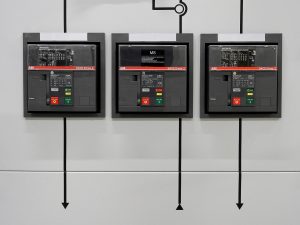An electrical contractor needs to be familiar with a lot of things in their industry. They have to know all of the tools they are using, what they are used for, and the slang that is used. This helps them clearly communicate concepts to their customers while being familiar with the lingo used by the professionals. In particular, they need to watch out when terms are used interchangeably. The last thing any contractor wants to experience is a costly error due to something as simple as a misunderstanding.

One of the most common misunderstandings within the electrical construction industry is the difference between a switchboard and switchgear. A closer look into things such as their specifications, testing standards and physical design will reveal that these are two very different pieces of equipment that each serve different purposes. Here is a brief overview of the key differences that you should be looking out for:
Function
First, let’s look at the definition of both terms so we can understand how a switchboard and switchgear differ from one another. A switchboard can be defined as a device composed of an assembly of panels that can direct electricity from one source to the other. Every panel within the switchboard allows the electricity to be redirected through the use of installed switches.
A switchgear, on the other hand, consists of several circuit breakers, disconnect switches and fuses that allow for the protection, isolation and control of electricity-powered equipment. In effect, they can interrupt faults and short circuits without affecting the other circuits, allowing them to provide continuous service to certain machinery and processes.
Size
Depending on the location in which the equipment will be installed, there are arguably situations in which one is better than the other. Switchboards require less room as they work primarily through front access. Switchgears are different because they require both rear and front access for cable terminations, and thus they take up more space.
Price
In general, switchgear is considered to be more expensive than switchboards due to the complexity of setup and the materials that are used. With that said, it is important to also note that individually mounted switchboards are costlier that switchboards that are group mounted.
Circuit Breakers Used
This happens to be one of the major differences between the two that will allow you to tell one apart from the other. A switchgear will use low-voltage power circuit breakers that conform to the standards NEMA SG-3 and ANSI C37.20.1, whereas switchboards will employ molded-case circuit breakers and insulated case circuit breakers that adhere to the standards of UL-891 and NEMA PB-2.
Testing
While both are dielectric tested at 2200 V, there are some subtle differences within the testing process. The switchboard is short circuited tested at a power factor of 20% for a duration of 3 cycles, while switchgears are tested at 15% for 30 cycles.
Real World Applications
There are situations where one might be a better choice than the other. It comes down to including all of the above factors and making a decision based on the information available. For example, let’s say that you wanted to determine which of the two to use for a round-the-clock operation such as an hospital or an airport.
You might be tempted to go for the switchboard because of its lower cost, but there comes the issue of reliability. If there was an accidental power outage, just 15 minutes would be enough to cause some serious financial and operational damage. In this case, it is worth investing the extra money towards a switchgear setup. The precise coordination of circuit breakers combined with the reduced frequency of power outages will save more money in the long term and result in fewer errors. For schools, retail facilities, commercial buildings, laboratories, and any other building of the sort, a switchboard would be the more optimal choice.
Now that you know the difference between a switchboard and switchgear, you will know which one is best suited for your next project. It is important to treat your choice as a case-by-case scenario in which multiple factors are taken into account. There is no one-size-fits-all solution in the electrical construction industry and the choice between using a switchboard or switchgear is not an exception to this rule.
